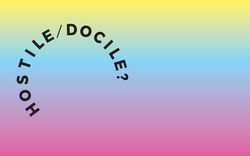Sensations urbaines
Sensations urbaines explore les perceptions et phénomènes urbains traditionnellement négligés, réprimés ou même dépréciés. Récusant la domination de l’impression visuelle dans l’environnement urbain, l’exposition, qui propose une réinterprétation des qualités latentes de la ville, offre une analyse complexe des commodités, des systèmes de communication et des dimensions(...)
Salles principales
26 octobre 2005 au 10 septembre 2006
Sensations urbaines
Actions:
Description:
Sensations urbaines explore les perceptions et phénomènes urbains traditionnellement négligés, réprimés ou même dépréciés. Récusant la domination de l’impression visuelle dans l’environnement urbain, l’exposition, qui propose une réinterprétation des qualités latentes de la ville, offre une analyse complexe des commodités, des systèmes de communication et des dimensions(...)
Salles principales
Projet
AP148.S1.1970.PR02
Description:
The project series documents Poli's work on the Interplanetary Architecture project, which was also made into a film by Superstudio directed by Alessandro Poli (the film is not included in the fonds). The project reflects Poli's deep fascination with the moon landing in 1969. Poli uses this major media event as a catalyst for thinking about a new approach to architecture and tools for design, including the idea that film and the movie camera should become part of the toolset. The project also seems to be in some way a response to Epoch magazine's challenge for a "Primo concorso di architettura nello spazio" (the first architectural competition in space), and includes much imagery and textual references to a new road or architectural links between the earth and other planets, including an earth moon highway. In his storyboard, Poli also makes reference to his earlier Piper project, and some imagery features wheels and an amusement park. The Interplanetary Architecture project was exhibited by Superstudio in Rome in 1972 and featured in "Casabella" magazine in April 1972 (no. 364). The project was also featured in the 2010 CCA exhibition "Other Space Odysseys". In the accompanying CCA publication, Poli describes this project as "a voyage off earthbound routes in quest of architecture unfettered by the urban nightmare, by induced needs or by planning as the only tool for regulating and solving the world's problems" (Poli quoted in Borasi and Zardini, 2010, 110). Poli's work on this project is deeply tied to the Zeno project, which was also featured in this exhibition and is included in this fonds (see AP148.S1.1972.PR01). For the Zeno project, Poli envisioned a dialogue between astronaut Buzz Aldrin and an Italian peasant, Zeno of Riparbella. Poli felt that these two shared a similarity in that both their homes were isolated capsules, one that provided a lens from which to see the rest of the world and understand their place in it. The material in the series includes numerous photomontages and collages of astronauts in space, as well as drawings of plantery shapes and structures. There are also texts, some of which include calculations of distances and diameters of planets, as well as notebooks and sketchbooks, many of which Poli included in a folder he entitled "Storyboard." The series also includes an unsent letter from Poli to Adolfo Natalini which describes how, after the moon landing, everything - the planet, the moon, the stars - is architecture, and that this will necessitate the need for new design tools, such as the movie camera. Some works are signed Alessandro Poli-Superstudio. Source cited: Giovanna Borasi and Mirko Zardini, eds., Other Space Odysseys, Montreal and Baden: Canadian Centre for Architecture/Lars Müller Publishers, 2010.
1969-1971
Architettura Interplanetaria [Interplanetary Architecture] (1970-1971)
Actions:
AP148.S1.1970.PR02
Description:
The project series documents Poli's work on the Interplanetary Architecture project, which was also made into a film by Superstudio directed by Alessandro Poli (the film is not included in the fonds). The project reflects Poli's deep fascination with the moon landing in 1969. Poli uses this major media event as a catalyst for thinking about a new approach to architecture and tools for design, including the idea that film and the movie camera should become part of the toolset. The project also seems to be in some way a response to Epoch magazine's challenge for a "Primo concorso di architettura nello spazio" (the first architectural competition in space), and includes much imagery and textual references to a new road or architectural links between the earth and other planets, including an earth moon highway. In his storyboard, Poli also makes reference to his earlier Piper project, and some imagery features wheels and an amusement park. The Interplanetary Architecture project was exhibited by Superstudio in Rome in 1972 and featured in "Casabella" magazine in April 1972 (no. 364). The project was also featured in the 2010 CCA exhibition "Other Space Odysseys". In the accompanying CCA publication, Poli describes this project as "a voyage off earthbound routes in quest of architecture unfettered by the urban nightmare, by induced needs or by planning as the only tool for regulating and solving the world's problems" (Poli quoted in Borasi and Zardini, 2010, 110). Poli's work on this project is deeply tied to the Zeno project, which was also featured in this exhibition and is included in this fonds (see AP148.S1.1972.PR01). For the Zeno project, Poli envisioned a dialogue between astronaut Buzz Aldrin and an Italian peasant, Zeno of Riparbella. Poli felt that these two shared a similarity in that both their homes were isolated capsules, one that provided a lens from which to see the rest of the world and understand their place in it. The material in the series includes numerous photomontages and collages of astronauts in space, as well as drawings of plantery shapes and structures. There are also texts, some of which include calculations of distances and diameters of planets, as well as notebooks and sketchbooks, many of which Poli included in a folder he entitled "Storyboard." The series also includes an unsent letter from Poli to Adolfo Natalini which describes how, after the moon landing, everything - the planet, the moon, the stars - is architecture, and that this will necessitate the need for new design tools, such as the movie camera. Some works are signed Alessandro Poli-Superstudio. Source cited: Giovanna Borasi and Mirko Zardini, eds., Other Space Odysseys, Montreal and Baden: Canadian Centre for Architecture/Lars Müller Publishers, 2010.
Project
1969-1971
Sustainable?
Sustainable? est un colloque international réunissant des personnes de diverses disciplines pour explorer les questions de développement durable reliées à l’architecture. Organisés par l’architecte et chercheur Iñaki Àbalos, le colloque et la table ronde situent historiquement l’engagement de l’architecture envers le développement durable, et mettent en place un programme(...)
Paul Desmarais Theatre
16 juin 2007 au 17 juin 2007
Sustainable?
Actions:
Description:
Sustainable? est un colloque international réunissant des personnes de diverses disciplines pour explorer les questions de développement durable reliées à l’architecture. Organisés par l’architecte et chercheur Iñaki Àbalos, le colloque et la table ronde situent historiquement l’engagement de l’architecture envers le développement durable, et mettent en place un programme(...)
Paul Desmarais Theatre
Les enseignements de… Ruscha et Venturi Scott Brown, 1962-1977 fait état de la relation entre les livres illustrés de l’artiste Edward Ruscha et des architectes Robert Venturi et Denise Scott Brown qui portent sur l’architecture et l’urbanisme du quotidien à Los Angeles et Las Vegas durant les années 1960 et 1970. Every Building on the Sunset Strip, de Ruscha, et(...)
Salle octogonale
31 mars 2004 au 30 mai 2004
Les enseignements de… Ruscha et Venturi Scott Brown, 1962-1977
Actions:
Description:
Les enseignements de… Ruscha et Venturi Scott Brown, 1962-1977 fait état de la relation entre les livres illustrés de l’artiste Edward Ruscha et des architectes Robert Venturi et Denise Scott Brown qui portent sur l’architecture et l’urbanisme du quotidien à Los Angeles et Las Vegas durant les années 1960 et 1970. Every Building on the Sunset Strip, de Ruscha, et(...)
Salle octogonale
articles
Hostile/Docile
Notre client, la planète
À partir d’hypothèses et de points de vue différents, Cedric Price, Aldo Rossi, James Stirling et Gordon Matta-Clark se sont engagés dans un processus de reformulation radicale du statut, de l’histoire et du rôle de l’architecture. sortis du cadre: price rossi stirling + matta-clark fait entrer en dialogue les réflexions de quatre figures marquantes des années 1970 à(...)
Salles principales
23 octobre 2003 au 6 septembre 2004
sortis du cadre : price rossi stirling + matta-clark
Actions:
Description:
À partir d’hypothèses et de points de vue différents, Cedric Price, Aldo Rossi, James Stirling et Gordon Matta-Clark se sont engagés dans un processus de reformulation radicale du statut, de l’histoire et du rôle de l’architecture. sortis du cadre: price rossi stirling + matta-clark fait entrer en dialogue les réflexions de quatre figures marquantes des années 1970 à(...)
Salles principales
La pratique muséologique, telle qu’elle a émergé au cours du XXe siècle, est sans contredit profondément remaniée. Les changements radicaux dans le statut de l’objet, de la culture, des diverses disciplines ou de l’information et de l’éducation entraînent une inévitable transformation du rôle et des compétences du conservateur. Un intérêt renouvelé pour la pratique(...)
Théâtre Paul-Desmarais
11 novembre 2010 au 13 novembre 2010
Le CCA dans un champ muséologique en expansion
Actions:
Description:
La pratique muséologique, telle qu’elle a émergé au cours du XXe siècle, est sans contredit profondément remaniée. Les changements radicaux dans le statut de l’objet, de la culture, des diverses disciplines ou de l’information et de l’éducation entraînent une inévitable transformation du rôle et des compétences du conservateur. Un intérêt renouvelé pour la pratique(...)
Théâtre Paul-Desmarais
articles
Développement durable?
Notre client, la planète
Des architectes, des artistes et des collectifs en provenance de plusieurs pays redéfinissent des activités en apparence anodines comme le jardinage, le recyclage, le jeu ou la marche. Confrontées aux normes de comportement urbain communément admises, leurs actions vont parfois jusqu’à défier les prescriptions de la loi. Les groupes ou les individus mis en scène dans(...)
Salles principales
26 novembre 2008 au 19 avril 2009
Actions : comment s’approprier la ville
Actions:
Description:
Des architectes, des artistes et des collectifs en provenance de plusieurs pays redéfinissent des activités en apparence anodines comme le jardinage, le recyclage, le jeu ou la marche. Confrontées aux normes de comportement urbain communément admises, leurs actions vont parfois jusqu’à défier les prescriptions de la loi. Les groupes ou les individus mis en scène dans(...)
Salles principales
1973 : Désolé, plus d’essence analyse l’innovation architecturale à laquelle a donné naissance la crise énergétique de 1973, alors que la valeur du baril de pétrole augmentait de façon exponentielle, donnant lieu à des bouleversements économiques, politiques et sociaux dans de nombreux pays. Présentant plus de 350 objets – dessins d’architecture, photographies,(...)
Salles principales Mot(s)-clé(s):
1973, désolé plus d'essence, crise du pétrole, énergie, environnement
7 novembre 2007 au 20 avril 2008
1973 : désolé, plus d’essence
Actions:
Description:
1973 : Désolé, plus d’essence analyse l’innovation architecturale à laquelle a donné naissance la crise énergétique de 1973, alors que la valeur du baril de pétrole augmentait de façon exponentielle, donnant lieu à des bouleversements économiques, politiques et sociaux dans de nombreux pays. Présentant plus de 350 objets – dessins d’architecture, photographies,(...)
Salles principales Mot(s)-clé(s):
1973, désolé plus d'essence, crise du pétrole, énergie, environnement








